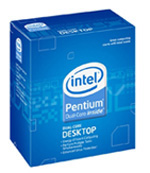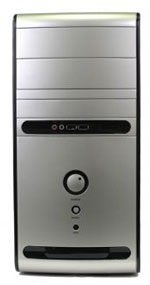Intel Entry-level PC
While Intel still owns the top in the CPU performance, the area from entry to upper midrange is very competitive between Intel and AMD. As pointed out in our Phenom II Guide, the only area still dominated by Intel is the very top, with CPUs at $300 and more. The one advantage that remains for Intel is that their processors generally overclock much better than current AMD CPUs, but that has changed with Phenom II in the midrange. This is not normally a consideration in entry computers, but it could be for some buyers, and at the lowest rungs of the CPU ladder Intel processors remain the best overclockers for now.
| Intel Entry-level PC | ||
| Hardware | Component | Price |
| Processor | Intel Pentium Dual-Core E5200 Wolfdale (2.5GHzx2 65W 2MB L2 800 FSB) |
$73 |
| Cooling | CPU Retail HSF | $- |
| Video | On-Board | $- |
| Motherboard | ECS GF7100PVT-MT NVIDIA GeForce 7100 HMDI | $60 |
| Memory | G.Skill 4GB (2x2GB) DDR2-800 | $37 |
| Hard Drive | WD Caviar GP WD5000AACS 500GB | $59 |
| Optical Drive | Samsung 22X DVDRW/DL SH-S223Q | $25 |
| Audio | On-Board | $- |
| Case | HEC 6K28BSOH48D Micro ATX Mini Tower 485W Power Supply | $50 |
| Power Supply | Included with Case | $- |
| Base System Total | $304 | |
| Display | Hanns-G HB-175APB Black 17" 8ms Widescreen LCD Monitor Built in Speakers - Retail (1440x900) | $99 |
| Speakers | Built-in Monitor | $- |
| Input | Microsoft CA9-00001 Black PS/2 Standard Keyboard and Optical USB/PS2 Mouse - OEM | $16 |
| Operating System | Microsoft Vista Home Premium OEM | $99 |
| Complete System Bottom Line | $518 | |
 |
Our choice for the Intel entry CPU remains the excellent 2.5GHz dual-core E5200 Wolfdale. This 65W rated CPU is built on Intel's 45nm manufacturing that begs you to overclock. The E5200 is rated 800FSB, so right out of the box the first option for overclock, if you are inclined, is to bump it up to a 1066 bus. Even if you never overclock you will be very pleased with the performance of the E5200. The E5200 is an easier choice now that the price is $10 lower at $73 than it was just three months ago. We do not recommend going lower than an E5200 in an Intel system because the trade-offs in performance for the few dollars saved are too great. The E1200 at $50, for example, is dismal compared to the E5200, and certainly not a good choice in performance for the $23 saved.
 |
Unfortunately our favorite Zotac N73PV-Supreme board has been discontinued by Zotac. This was a real surprise considering how well the $60 board sold. The NVIDIA 7100 used in the Zotac is a good chipset choice for an entry Intel 775, so we have chosen the ECS GF7100PVT-MT at the same $60 for the entry Intel system. There is currently a $10 rebate that lowers the price to $50. The ECS provides HDMI output with a DVI to HDMI adapter. If you prefer a real HDMI output on the rear panel you can choose the Gigabyte GA-73PVM-S2H LGA at $69.
 |
The case for the Intel entry system is the solid HEC 6K28BSOH48D Micro ATX mini-tower. HEC is best known as a manufacturer of power supplies. Some are sold under their name, but most are manufactured for other well known power supply brands. HEC includes a 485W PSU with this attractive mini-tower, which should provide plenty of power for your entry Intel build. If you prefer a mid-tower case HEC uses the same PSU in the $50 HEC 6C60BSOH48. You could also choose the Sigma La Vie Aluminum mid-tower featured in the AMD build on the previous page. The rest of the components are virtually identical to the AMD entry-level system.
If we compare the two entry-level systems, the winner depends on what is of value to you. The Intel system is a bit more powerful, but you can move up to a high-end Athlon 64 X2 or a low-end AMD Phenom X3 for comparable performance at less than $100. The full-size AMD ASRock board offers more flexibility for future graphics expansion, with two x16 PCI-E slots and CrossFire X support. If you are a gamer on a strict budget the AMD entry system offers you more for future graphics expansion. For the typical entry-level PC right now and for what the system is typically used for - internet, office, low-end gaming, and low to mid graphics - you can go either route and be very happy.










66 Comments
View All Comments
7Enigma - Monday, March 16, 2009 - link
I think you're splitting hairs. Both of their Budget systems are fine for gaming if you add in a discrete graphics card. And in both system descriptions they mention adding a graphics card. Reading between the lines means add a graphics card and you have a gaming rig.Pretty simple.
frozentundra123456 - Monday, March 16, 2009 - link
With prices so low, I would say to include a mid-range graphics card such as the HD4670 with any system. The 4670 uses very little power and will improve video and allow decent basic gaming for less than 100.00 additional cost. It seems it is worth this even for the lowest end system which would still cost about 500.00 with monitor and OS and no graphics card.Hrel - Monday, March 16, 2009 - link
You can get a 640GB Hard Drive from Seagate with 32MB of cache, a 7200rpm speed and SATA connection for $60. So, 500GB or 640GB for $60? Hm, tough choice... sarcasm.MrSpadge - Saturday, March 21, 2009 - link
I agree, the systems should have faster HDDs! I'd choose the WD 640 GB 7200 rpm over the Seagate for speed. The WD green power has amazingly tuned firmware and it's faster than many elder 7200 rpm dirves, but it's not a magician and is held back by its 5400 rpm.Just think for a moment what limits the performance of a PC under "normal" use. What happens when you get to an elder machine, even with a healthy windows? Well, if you tell it to do anything you'll be greated by a constant "crrrrrrrr" from the HDD. Not the CPU or GPU is limiting, it's the HDD! That's why going with a 5400 rpm drive is almost silly.. you give up 15 - 20% speed and gain ~3W in power consumption. For the HTPC it's alright though, as it doesn't keep you from working if you have to wait for the HDD.
Hrel - Monday, March 16, 2009 - link
sorry, my bad, that drive is $70 now; it was $60 dollars like week ago though.AntiM - Monday, March 16, 2009 - link
I would say that 85% or more people could get by just fine with these machines. They are perfect for simple office machines. You could probably go even cheaper on the AMD system with an Athlon 64 X2 5600+ and 2 GB or RAM and still have plenty of horsepower for an office machine.Wesley Fink - Monday, March 16, 2009 - link
You can definitely go lower on the AMD CPU, but do you really think anyone would want to pay $67 for a 5600+ or 5600 Brisbane, when they can get a 7750 Kuma Black Edition for $7 LESS at $60. Pricing in entry space can be very strange.I also think dropping RAM from 4GB to 2GB is not very cost effective when you save just $17 by halving the RAM. If every penny counts I guess that that $17 could be important.
AgeOfPanic - Monday, March 16, 2009 - link
With the decoding capabilities of the current IGP chipsets why choose a Phenom processor with higher TDP over a Athlon X2 5050E?Penti - Tuesday, March 17, 2009 - link
A lot of people use homebrew (unlicensed) codecs for warez and their video watching. Those are usually software only or have a limited support for DXVA. Like many alternative media-portal/center software. If you don't want that flexibility there are other devices that even play warez that might fit your bill. But it's only commercial codecs that has decent hardware acceleration. You might also need the power for recording and encoding.7Enigma - Monday, March 16, 2009 - link
I think the answer is, "because we can". Honestly for a true HTPC the last article was fine, and nothing has really changed since then IMO. Yes you can for the same money get a more powerful system or even slightly cheaper, but the HTPC's job is not to be more and more powerful for the same/less money, it's to be cool and quiet while allowing for 1080p and all the resolutions below.Where the latest HTPC systems are beneficial is if you are using the HTPC box to rip or encode to different compressed formats while simultaneously watching something else, and/or recording multiple signals. Then it will be beneficial to have the Phenom II 3-core over a lowly X2.